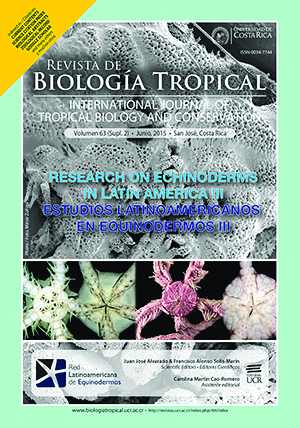Abstract
Lytechinus variegatus (Lamarck) is a common echinoid found on the Atlantic coast of America from North Carolina to southern Brazil and their populations inhabit sub littoral shallow-water environments. This research examined some aspects of reproduction in the southern limit of distribution of the species. A total of 86 adult individuals of L. variegatus (50.8 to 77.0 mm test diameter) were manually collected from September 2000 to September 2001 along the unconsolidated bottoms at the eurihaline sector of Paranaguá Bay (48° 19’ W - 25° 35’ S) for histological characterization of gametogenesis, sex ratio and gonadal index (GI) evaluation. This population showed a synchronicity in maturation and spawning events (autumn and winter respectively), with a 1:1 sex ratio (χ2 = 2.57, df = 7, p < 0.05). The GI increase was associated with storage of nutritional resources periods (resting stages and proliferation) that occurred between late winter and spring. Biometric analyzes indicated a greater investment in size and/or quantity of gametes between late spring and summer, when it was possible to observe mature sperm occupying on average 63.9 % of the follicular lumen and oocytes reaching values of 70.0 to 75.0 μm. Mature oocyte mean size is the highest diameter of those developed by other regular echinoids in the same latitude. However, the average diameter of mature oocytes of L. variegatus in the southern limit of its distribution was lower than the values recorded for the northern hemisphere.
References
Beddingfield, S. D., & McClintock, J. B. (1994). Environmentally-induced catastrophic mortality of the sea urchin Lytechinus variegatus in shallow sea grass habitats of St Josephs Bay, Florida. Bulletin of Marine Science, 55, 235-240.
Beddingfield, S. D., & McClintock, J. B. (1998). Diferencial survivorship, reproduction, growth, and nutrient allocation in the regular echinoid Lytechinus variegatus (Lamarck) fed natural diets. Journal of Experimental Marine Biology and Ecology, 226, 195-215.
Beddingfield, S. D., & McClintock, J. B. (2000). Demographic characteristics of Lytechinus variegatus (Echinodermata: Echinoidea) from three habitats in a North Florida Bay, Gulf of Mexico. P.S.Z.N. Marine Ecology, 21, 17-40.
Bishop, C. D., Lee K. J., & Watts, S. A. (1994). A comparison of osmolality and specific ion concentrations in the fluid compartments of the regular sea urchin Lytechinus variegatus Lamarck (Echinodermata: Echinoidea) in varying salinities. Comparative Biochemistry and Physiology, 108A, 497-502.
Cameron, R. A. (1986). Reproduction, larval occurrence and recruitment in Caribbean sea urchins. Bulletin of Marine Science, 39, 332-346.
Ernest, R. G., & Blake, N. J. (1981). Reproductive patterns within subpopulations of Lytechinus variegatus (Lamarck) (Echinodermata: Echinoidea). Journal of Experimental Marine Biology and Ecology, 55, 25-37.
Hammer, B.W., Hammer, H. S., Watts, S.A., Desmond, R.A., Lawrence, J. M. & Lawrence, A. L. (2004). The effecs of dietary protein concentration on feeding and growth of small Lytechinus variegatus (Echinodermata: Echinoidea). Marine Biology, 145, 1143-1157.
Junqueira, A. O. R. (1998). Biologia populacional de Lytechinus variegatus (Lamarck, 1816) em habitats contrastantes do litoral do Rio de Janeiro, Brasil (Tese de doutorado). Universidade de São Paulo, Brasil.
Junqueira, A. O. R., Ventura, C. R. R., Carvalho, A. L. P. S., & Schimdt, A. J. (1997). Population recovery of the sea urchin Lytechinus variegatus in a seagrass flat (Araruama Lagoon, Brazil): The role of recruitment in a disturbed environment. Invertebrate Reproduction & Development, 31, 143-150.
Lawrence, J. M. (1975). The effect of temperature-salinity combinations on the functional well-being of adult Lytechinus variegatus (Lamarck) (Echinodermata, Echinoidea). Journal of Experimental Marine Biology and Ecology, 18, 271-275.
Lawrence, J. M., & Bazhin, A. (1998), Life-history strategies and the potential of sea urchins for aquaculture. Journal of Shellfish Research, 17, 1515-1522.
Lawrence, J. M. (2001). Edible sea urchins: biology and ecology. Amsterdam: Elsevier.
Lana, P. C., Marone, E., Lopes, R. M., & Machado, E. C. (2001). The subtropical estuarine complex of Paranaguá Bay. Coastal Marine Ecosystems of Latin America, 144, 132-145.
Lessios, H. A. (1985). Annual reproductive periodicity in eight echinoid species on the Caribbean coast of Panama. Proceedings of 5th Echinoderms Conference, Galway, 303-311.
Lessios, H. A. (1987). Temporal and spatial variation in egg size of 13 Panamanian echinoids. Journal of Experimental Marine Biology and Ecology, 114, 217-239.
Lessios, H. A. (1991). Presence and absence of monthly reproductive rhythms among eight Caribbean echinoids off de coast of Panama. Journal of Experimental Marine Biology and Ecology, 153, 27-47.
Machado, E. C., Daniel C. B., Brandini, N., & Queiroz, R. L. V. (1997). Temporal and spatial dynamics of nutrients and particulate suspended matter in Paranaguá Bay, PR, Brazil. Neritica, 11, 17-36.
Moore, H. B., Jutare T., Bauer, J. C., & Jones, J. A. (1963). The biology of Lytechinus variegatus. Bulletin of Marine Science, 13, 23-53.
Moore, H. B., & McPherson, B. F. (1965). A contribution to the study of the productivity of the urchins Tripneustes esculentus and Lytechinus variegatus. Bulletin of Marine Science, 15, 855-871.
Moore, H. B., &, Lopez, N. N. (1972) Factors controlling variation in the seasonal spawning pattern of Lytechinus variegatus. Marine Biology, 14, 275-280.
Pearse, J. S., & Cameron, R. A. (1991) Echinodermata: Echinoidea. In A. C. Giese, J. S. Pearse, & V. Pearse, (Eds.), Reproduction of marine invertebrates Vol. VI Echinoderms and Lophophorates (pp: 514-662). Pacific Grove: The Boxwood Press.
Tavares, Y. A. G. (2004). Biologia reprodutiva dos equinóides Echinometra lucunter (Linnaeus, 1758) e Arbacia lixula (Linnaeus, 1758) (Echinodermta:Echinoidea) na Ilha da Galheta, litoral paranaense, Brasil (Tese de doutorado). Universidade Federal do Paraná, Brasil.
Tavares, Y. A. G., & Borzone, C.A. (2006). Reprodutive cycle of Mellita quinquiesperforata (Leske) (Echinodermta:Echinoidea) in two contrasting beach environments. Revista Brasileira do Zoología, 23, 573-580.

This work is licensed under a Creative Commons Attribution 4.0 International License.
Copyright (c) 2015 Revista de Biología Tropical

